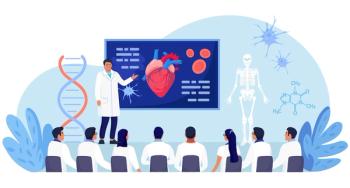
Should physicians share their notes with patients?
How allowing patients to read notes can strengthen the bond for a physician.
There was a time when doctors were protective of the information they entered into a patient’s record. However, with the advent of
Hot topic:
In 2010, a study of 105 primary care physicians from Beth Israel Deaconess Medical Center, Geisinger and Harborview Medical Center, had doctors sharing their notes with approximately 20,000 patients for one year. By the conclusion of what was called the OpenNotes study, all of the physicians involved continued sharing notes.
That sparked a huge interest in OpenNotes, and ever since, there has been an increasing number of prominent health systems and doctors who have opened up access to their notes to their nearly 20 million patients.
The benefits of sharing notes
According to the Robert Wood Johnson Foundation, the creators of the OpenNotes study, when physicians share notes with their patients, it allows for a more open dialogue between doctor and patient, which can build trust and lead to more motivated and adherent patients. Additionally, it may enable patients to feel empowered and be more willing to discuss topics that may be difficult for them.
Donald Rebhun, MD, corporate medical director of HealthCare Partners, Mission Hills, California, supports the industry’s movement toward allowing patients to review the notes in their medical records.
Related:
“Open discussion and sharing of notes promotes a shared-decision model that differs from the traditional model of the physician evaluating the patient and telling them what to do,” he says. “Today, rather than physicians deciding what is important ‘for’ their patient, it is now better to decide ‘with’ their patient. This leads to better understanding,
James Legan, MD, a primary care physician with Northwest Physicians, Great Falls, Montana, says not only should notes be shared with patients, but he thinks they should be put on the big screen during the patient visit.
By utilizing an HDMI cable, remote access and a TV in the patient room, Legan projects patients’ records on the 24-inch TV screen, which helps him boost patient engagement, identify potential inaccuracies in medical records and improve overall care.
“Mirroring a patient’s record on a TV screen makes a patient visit interactive and visually engages them in their care. It also brings in an element of transparency that enhances the patient-doctor relationship, making it more collaborative and, therefore, productive,” Legan says. “Displaying the EHR on a TV also helps the patient recognize trending (e.g. decline in weight, increase in blood pressure levels, etc.). The visualization of trending charts keeps patients motivated to stay healthy in and out of the office because they don’t want to see negative progress.”
Further reading:
Faisal Tawwab, MD, a family practice specialist with Multicare Physicians in Orlando, Florida, says the future is going to be about complete transparency, and physicians need to be responsible for recognizing the trend and to embrace it.
“If we know patients will have access to their notes, we as physicians will go the extra mile to make those notes as comprehensive, accurate and easy-to-digest as possible,” he says. “I tend to write bullet points that summarize our visit and make the patient’s next steps clear to understand. I also document every piece of advice and counsel I provided the patient.”
Note-sharing requires discretion
Some physicians may feel threatened and concerned about patients being offended or upset about what they have written in their notes, and are against sharing them.
Further reading:
“They may be concerned about observations and opinions they have included, which may lead to more questions, more time and disruption of the doctor-patient relationship,” Rebhun says. “I understand the concerns many physicians have about sharing notes with their patients, but feel it is worthwhile to pursue efforts that build trust-an essential component for a strong physician-patient relationship.”
Legan once met a colleague who told him there was no way he was sharing notes with patients because he didn’t want to reveal some of the more sensitive details he wrote during visits so he could better remember traits of the patients.
“I was always taught that if you are going to put anything in the chart, envision yourself sitting in front of a judge and jury and make sure you are comfortable reading that in front of everyone,” he says. “I try not to ever put anything insulting or degrading.”
Blog:
Pradeep K. Vangala, MD, president of Orlando Internal Medicine, says the reasons the medical industry may be opposed to a physician sharing notes with patients pertain to
“We leverage the text processing and sensitive data filtering capabilities provided by (patient engagement solution) HealthGrid’s platform to identity if any sensitive information is recorded in the EMR chart for a patient or is present in raw notes,” he says. “If HealthGrid detects any sensitive information in our notes then, we have asked them to share only generic visit information along with intervention and plan of care information.”
Making notes readable
Doctors are notorious for bad handwriting and talking in “doctor speak,” and while most physicians have switched to doing their notes electronically, some still keep notes on paper. Regardless of whether notes are electronic or on paper, the same rules apply.
It’s important for notes to be written in patient-friendly language and tone, when possible. Most patients will not understand medical terminology or abbreviations often used by clinicians. Thus, it will take time and be an adjustment for physicians to simplify their notes and be aware of the impact on their patients.
Related:
Initially, having to write notes in a way that patients will understand may increase the amount of time spent because physicians need to consider word choice and reduce their medical jargon as much as possible.
“Given the ubiquity of electronic health records programs, it is a far less daunting task to share electronic notes versus the handwritten charts of the past,” Rebhun says. “Similar to EHR adoption, this is a matter of retraining how we record and share information in an effort to help our patients become more active participants in their care.”
He says providing patients access to their physicians’ notes is a great way to remind them of what they discussed during their appointment and review the details.
“Patients often gain clarity on earlier discussions and some feel an increased sense of trust knowing exactly what the physician wrote in their notes,” Rebhun says. “By having access to the notes, patients can jog their memory and share the physician’s recommendations with a family member or caregiver who can help to reinforce care recommendations and decisions discussed with their physician.”
Newsletter
Stay informed and empowered with Medical Economics enewsletter, delivering expert insights, financial strategies, practice management tips and technology trends — tailored for today’s physicians.















